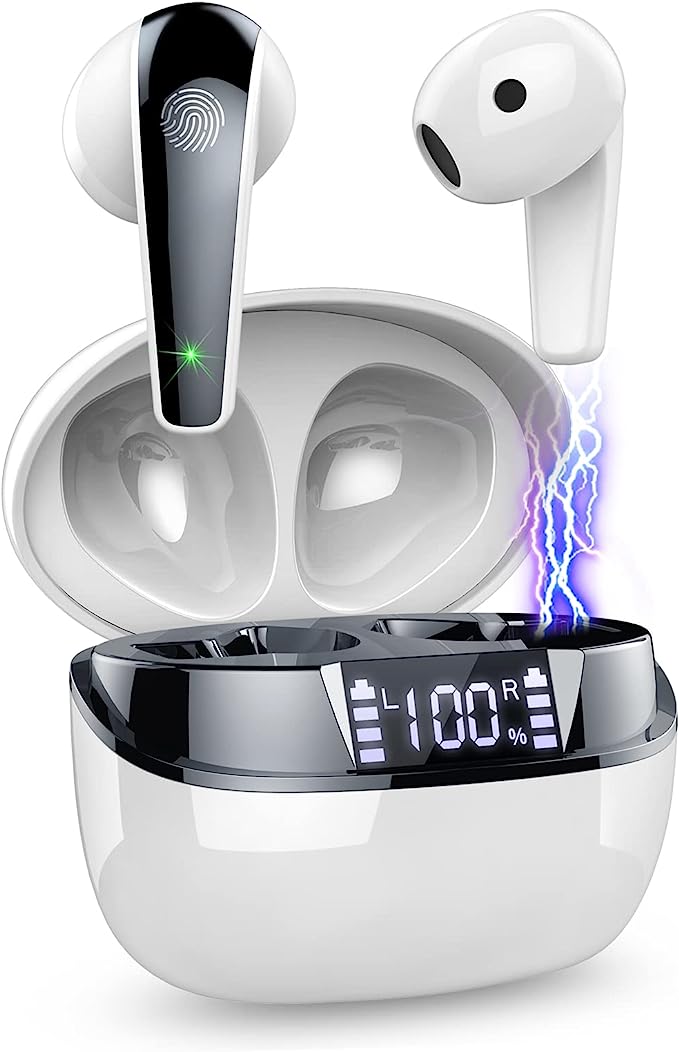Beyond the Hype: What Do Earbud Specs Like 'Bluetooth 5.4' and '13mm Driver' Really Mean?
Update on Oct. 30, 2025, 1:15 p.m.
Shopping for wireless earbuds can feel like drowning in a bowl of alphabet soup. Bluetooth 5.4. 13mm drivers. IPX5. 32-hour playtime. Every box screams technical jargon, but what do these specs actually mean for your daily commute, workout, or conference call?
It’s confusing, and frankly, a little frustrating. You just want to know if they’ll sound good, stay connected, and survive a little sweat.
Welcome to your official decoder ring.
I’m not here to sell you a specific product. I’m here to be your mentor, the tech-savvy friend who cuts through the marketing hype. We’re going to turn that confusion into confidence.
To make this practical, we’ll use a real-world example as our “guinea pig” for this lesson: the Monster N-Lite 210. We’re going to “dissect” its spec sheet to understand what really matters, not just for this pair, but for any pair of earbuds you’re thinking about buying.
By the end of this guide, you won’t just be a shopper; you’ll be an informed expert. Let’s begin.
Chapter 1: The “Engine” — What Is a 13mm Driver?
When you see a spec like “13mm oversized driver,” as found in the Monster N-Lite 210, this is the single most important component for sound quality.
Think of the driver as the engine of the earbud. It’s the tiny, powerful speaker that physically creates the sound waves. It works by vibrating a thin diaphragm (a cone) to move air, and that moving air is what your eardrum interprets as music.
Is Bigger Always Better?
In the world of drivers, 13mm is quite large for an in-ear bud. Here’s the simple physics:
- Large Driver (e.g., 13mm): A bigger diaphragm can move more air. This makes it much easier to produce deep, rich, and powerful bass frequencies. It’s the difference between a “tap” and a “thump.”
- Small Driver (e.g., 6mm): Smaller drivers can be incredibly precise, especially with high-frequency sounds (like cymbals and vocals), but they often struggle to produce that satisfying, room-filling bass without distortion.
But here is the mentor secret: Size is not the only thing that matters. A huge, cheap engine in a car is useless if it’s poorly tuned.
The same goes for earbuds. A large 13mm driver, like the one in our example, gives the potential for “Pure Monster Sound,” as the brand calls it. But the final sound also depends on:
- Tuning: How have the engineers electronically “tuned” the sound? Is it balanced, or did they just crank up the bass?
- Diaphragm Material: Is the diaphragm made of a cheap plastic or a rigid, advanced material that can vibrate without warping?
Your takeaway: When you see a large driver (10mm or more), consider it a good starting point for powerful, full-bodied sound. It shows the manufacturer is investing in the core “engine.”

Chapter 2: The “Connection” — The Bluetooth 5.4 Myth
Okay, let’s tackle the biggest number on the box: Bluetooth 5.4. This sounds very advanced. But should you choose a 5.4 earbud over a 5.3 or 5.2?
Here’s the honest truth: Probably not.
The differences between minor Bluetooth versions (like 5.2, 5.3, and 5.4) are almost unnoticeable to a normal user. The real revolution was Bluetooth 5.0, which gave us the speed, range, and dual-audio capabilities we love today.
Bluetooth 5.4, as seen in the Monster N-Lite 210, offers highly technical, minor improvements in security and “periodic advertising” (which you don’t use). It’s not a leap in sound quality.
So what should you be looking for instead of the version number?
1. Codecs (The “Language” of Bluetooth)
This is FAR more important. A codec is the software that compresses and decompresses your music. * SBC: The basic, mandatory codec. It’s fine, but not great. * AAC: Apple’s preferred codec. If you have an iPhone, earbuds that support AAC will sound better. * aptX/LDAC: Higher-quality codecs mostly found on Android phones. They transmit more data for “near-CD” quality sound.
Your takeaway: Don’t be dazzled by “Bluetooth 5.4.” Instead, if you’re an iPhone user, check for AAC. If you’re on Android, look for aptX.
2. Latency (The “Movie-Sync” Problem)
Latency is the tiny delay between your phone sending the sound and your earbud playing it. In early Bluetooth, this was terrible. You’d see lips move in a video, and the sound would come a half-second later.
Modern Bluetooth (anything 5.0 and up) has made this almost a non-issue. A spec like Bluetooth 5.4 ensures a “low latency listening experience,” which simply means your movies and games will be perfectly in sync. This is now the standard, and it’s a good one.

Chapter 3: The “Life-Proof” Factor — Decoding IPX5
You see this on almost every earbud: “IPX5 Waterproof.” This is perhaps the most misunderstood spec of all.
What does IPX5 really mean? Let’s break the code.
- I (Ingress): Stands for Ingress (how things get in).
- P (Protection): Stands for Protection.
- X (The first number): This rating is for dust protection. An ‘X’ means it was not tested for dust. This is common.
- 5 (The second number): This is the water protection rating. And this is the one you need to watch.
Here’s a simple breakdown of the water ratings: * IPX4: Protects from splashes of water from any direction. (Good for sweat). * IPX5: Protects from low-pressure jets of water. (e.g., you can rinse them under a gentle tap. This is a step up). * IPX7: Protects from full immersion in water up to 1 meter deep for 30 minutes. (This is “waterproof”).
So, the IPX5 rating on the Monster N-Lite 210 means it is sweat-proof and rain-proof. It’s perfect for the gym or getting caught in a downpour.
Crucial Mentor Warning: IPX5 is NOT shower-proof or swimming-proof. The steam from a hot shower or the pressure of swimming strokes will destroy them. “Water-resistant” and “waterproof” are very different. IPX5 is an excellent rating for sports and an active life, but don’t take them for a swim.

Chapter 4: The Specs That Really Matter (That Aren’t Numbers)
We’ve covered the big three technical specs. But as your mentor, I have to tell you: the most important features are often the ones that don’t have a flashy number.
1. Ergonomics and Fit
I cannot overstate this: If the earbuds don’t fit, none of the other specs matter.
Your 13mm driver could be the best in the world, but if the earbud doesn’t create a good seal in your ear canal, all that beautiful bass will leak out, and the sound will be thin and tinny.
This is why products like the N-Lite 210 emphasize “Ergonomic Fit Design” and include 3 different sizes of ear tips. This isn’t just for comfort; it’s for passive noise isolation. A good seal physically blocks outside noise, immersing you in the music without needing to crank the volume to dangerous levels.
Your takeaway: Always look for earbuds that come with multiple tip sizes. Your ear shape is unique, and a customizable fit is non-negotiable.
2. Battery Life (Buds vs. Case)
Marketers love to use the biggest number possible. You’ll see “32 Hours Battery Life” on the Monster N-Lite 210 box.
This is the Total Playtime. It means the earbuds themselves hold maybe 6-8 hours, and the charging case holds an additional 24-26 hours of recharges.
This is great, but the number you should really look for is the per-charge playtime. How long can you listen before you have to put them back in the case? Anything over 5 hours is solid. 8 hours is excellent. 32 hours is just the total you get before you need to find a wall outlet.
3. Controls (Touch vs. Button)
The N-Lite 210 uses “Easily Touch Control.” This is a personal preference, but here’s the trade-off:
* Touch Controls:
* Pro: Looks sleek. You don’t have to jam the earbud into your ear canal to pause the music. A gentle tap is all you need.
* Con: Can be “too” sensitive. Adjusting them in your ear, rain, or even your hair can trigger an accidental pause or skip.
* Physical Buttons:
* Pro: A satisfying, deliberate “click.” No accidental pauses.
* Con: You have to push the button, which can be uncomfortable.
There is no “right” answer here, but it’s a crucial part of the daily experience that you should consider.

Your Graduation: From Shopper to Expert
Let’s review what we’ve learned. You are no longer a “confused spec-shopper.”
- You know that a 13mm driver is a big “engine” that has great potential for bass, but the fit and tuning are what make it sing.
- You know that Bluetooth 5.4 isn’t a magical upgrade, and that connection codecs (like AAC) and low latency are what you actually experience.
- You know that IPX5 is a fantastic rating for sweat and rain, but it is not for swimming.
- And most importantly, you know that the “boring” specs like ergonomic fit and per-charge battery life are often more important than the big numbers on the box.
Whether you’re looking at the Monster N-Lite 210 or any other pair on the market, you now have the knowledge to see past the hype. You can confidently read a spec sheet, understand what it really means for you, and choose the perfect pair of earbuds for your life.
Well done. Class dismissed.



































